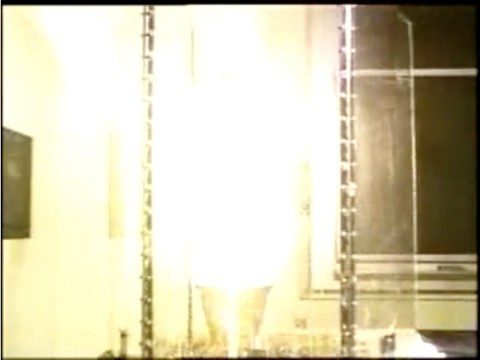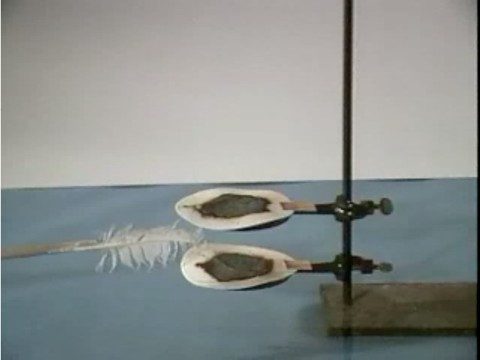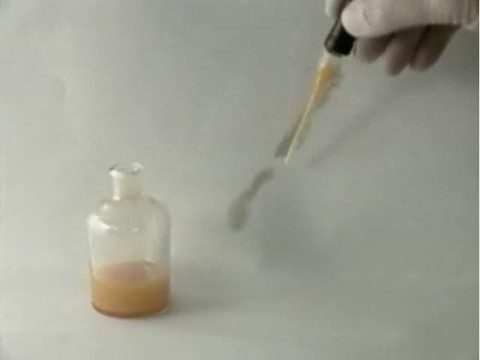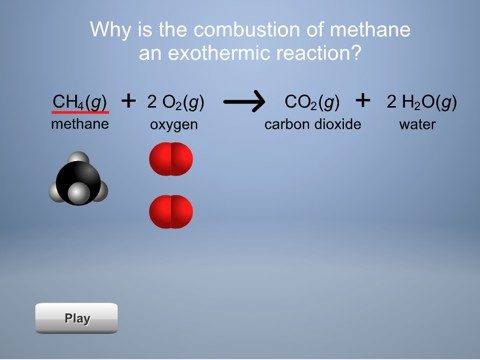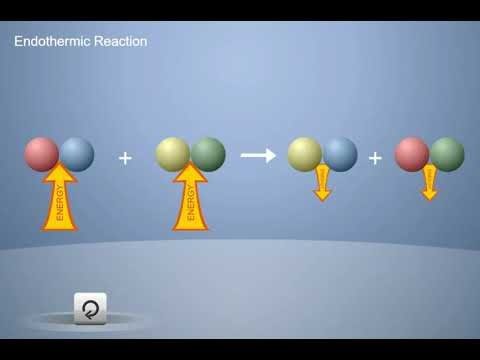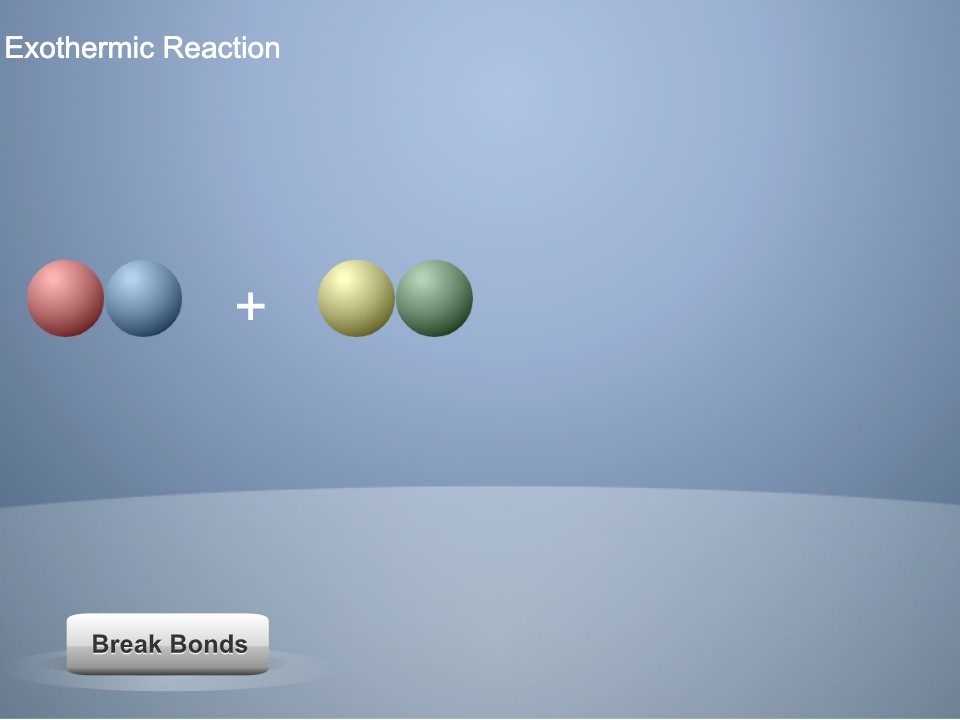Energy Changes in Chemical Reactions
Lesson Summary Video for teachers
Note: This video is designed to help the teacher better understand the lesson and is NOT intended to be shown to students. It includes observations and conclusions that students are meant to make on their own.
Key Concepts
- If two substances react and the temperature of the mixture decreases, the reaction is endothermic.
- If two substances react and the temperature of the mixture increases, the reaction is exothermic.
- A chemical reaction involves the breaking of bonds in the reactants and the forming of bonds in the products.
- It takes energy to break bonds.
- Energy is released when bonds are formed.
- If a reaction is endothermic, it takes more energy to break the bonds of the reactants than is released when the bonds of the products are formed.
- If a reaction is exothermic, more energy is released when the bonds of the products are formed than it takes to break the bonds of the reactants.
Summary
Students will conduct two chemical reactions. In the first, the temperature will go down (endothermic) and in the second, the temperature will go up (exothermic). Students will see an animation to review a concept that was introduced in Chapter 5 - that it takes energy to break bonds and that energy is released when new bonds are formed. Students will use this idea to explain why a reaction is either endothermic or exothermic.
Objective
Students will be able to define an endothermic and exothermic reaction. Students will be able to use the concept of energy in bond breaking and bond making to explain why one reaction can be endothermic and another reaction can be exothermic.
Safety
Be sure you and the students wear properly fitting goggles.
Materials for the Each Group
- Vinegar
- Baking soda
- Calcium chloride
- Water
- Thermometer
- 4 small cups
- Disposable self-heating hand warmer
- Self-inflating balloon
Additional Materials if You Choose to do the Extra Extend
- Magnesium sulfate
- Sodium carbonate
- Citric acid
- Universal indicator
Download All Lesson 6.7 Resources
Get the entire lesson plan and Student Activity Sheet for "Lesson 6.7 - Energy Changes in Chemical Reactions."
Online Assignments
Supplement in-class learning with interactive, multimedia-rich Google Forms lesson modules, perfect for reinforcing key chemistry concepts and scientific investigation skills.
Instructions
1 Engage
Step 1
Discuss the temperature changes in chemical reactions students have conducted so far.
Remind students that the decomposition reaction of hydrogen peroxide and the reaction with copper II sulfate and aluminum both caused the temperature of the solution to increase. Tell students that you will show them three chemical reactions where the temperature increases dramatically.
Project the video Thermite Reaction.
After adding one or more catalysts, iron oxide (rust) and aluminum react to produce elemental iron and aluminum oxide. So much heat is produced in this reaction that the iron becomes a liquid. The heat is so intense that the molten iron can be used to weld railroad tracks together.
Project the video Nitrogen Triiodide Reaction.
This is a decomposition reaction where nitrogen triiodide decomposes into nitrogen gas and purple iodine vapor. Nitrogen triiodide crystals are so unstable that just a light touch will cause them to rapidly decompose generating a great deal of heat.
Project the video White Phosphorus Reaction.
White phosphorus is dissolved in a solvent and spread on a piece of paper. When the solvent evaporates, the phosphorus reacts with oxygen in the air in a combustion reaction.
Ask students to make a prediction:
- Do you think substances can react and cause the temperature of the mixture to decrease?
Tell students that this lesson is going to explore temperature changes in chemical reactions.
2 Evaluate
Give each student an activity sheet.
- Lesson 6.7 Student Activity Sheet PDF | DOCX | Google Doc
- Lesson 6.7 Activity Sheet Answers PDF | DOCX | Google Doc
Download the student activity sheet, and distribute one per student.
The activity sheet will serve as the “Evaluate” component of each 5-E lesson plan. The activity sheets are formative assessments of student progress and understanding. A more formal summative assessment is included at the end of each chapter.
Students will record their observations and answer questions about the activity on the activity sheet. The Explain It with Atoms and Molecules and Take It Further sections of the activity sheet will either be completed as a class, in groups, or individually depending on your instructions. Look at the teacher version of the activity sheet to find the questions and answers.
3 Explore
Step 2
Have students measure the change in temperature of the reaction between baking soda and vinegar.
Question to Investigate
Does the temperature increase, decrease, or stay the same in the reaction between baking soda and vinegar?
Materials
- Vinegar in a cup
- Baking soda in a cup
- Thermometer
Materials Note: The amount of the solutions must be enough to cover the bulb of the thermometer. If they aren’t, use a smaller cup or clip the end of a plastic-backed thermometer so that the backing is flush with the bottom of the bulb.
Teacher Preparation
- Place about 10 mL of vinegar in a small plastic cup for each group.
- Place about ½ teaspoon of baking soda in a small cup for each group.
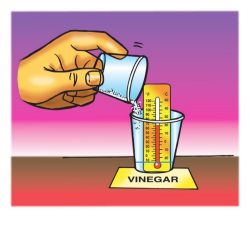
Procedure
- Place a thermometer in the vinegar. Read the thermometer and record the temperature on the activity sheet.
- While the thermometer is in the cup, add all the baking soda from your cup.
- Watch the thermometer to observe any change in temperature. Record the temperature after it has stopped changing.
Expected Results
If you begin with room-temperature vinegar, the temperature will decrease by about 7 °C. The amount of temperature decrease will vary. Carbon dioxide gas is also produced.
Step 3
Discuss student observations.
Ask students:
- Did the temperature increase, decrease, or stay the same when you combined baking soda and vinegar?
The temperature decreased. - What is the lowest temperature reached during your group’s reaction?
There will likely be some variation.
Tell students that when the temperature of a chemical reaction decreases, the reaction is called an endothermic reaction. The first part of the word, endo, means in or into and thermic has to do with heat or energy. So, an endothermic reaction means that more energy goes into making the reaction happen than is released by the reaction. This leaves the reaction mixture at a lower temperature.
Step 4
Have students measure the change in temperature of the reaction between baking soda solution and calcium chloride.
Question to Investigate
Does the temperature increase, decrease, or stay the same in the reaction between baking soda solution and calcium chloride?
Materials
- Baking soda solution in a cup
- Calcium chloride in a cup
- Thermometer
Teacher Preparation
- Make a baking soda solution by dissolving about 2 tablespoons of baking soda in 1 cup of water. Stir until no more baking soda will dissolve.
- Place about 10 mL of baking soda solution in a small plastic cup for each group.
- Place about ½ teaspoon of calcium chloride in a small cup for each group.
Procedure
- Place a thermometer in the baking soda solution. Read the thermometer and record the temperature on the activity sheet.
- While the thermometer is in the cup, add all the calcium chloride from the cup.
- Watch the thermometer to observe any change in temperature. Record the temperature when it stops changing.
Expected Results
The temperature of the solution should increase by about 15–20 °C. The temperature increase will vary. Carbon dioxide gas is produced, and a white cloudy precipitate, calcium carbonate, is formed.
Note: Some of the temperature increase in this reaction may be due to the chemical reaction between baking soda and calcium chloride, but some is also due to the exothermic way calcium chloride dissolves in water. Chapter 5 Lesson 9 addresses temperature changes as bonds between a solute are broken and the bonds between the solute and water are formed during the physical change of dissolving.
Read more about exothermic and endothermic chemical reactions in Teacher Background.
- Lesson 6.7 Teacher Background PDF
Step 5
Discuss student observations.
Ask students:
- Did the temperature increase, decrease, or stay the same when you combined baking soda solution and calcium chloride?
The temperature increased. - What is the highest temperature reached during your group’s reaction?
There will likely be some variation.
Tell students that when the temperature of a chemical reaction increases, the reaction is called an exothermic reaction. The first part of the word, exo, means out or out of, and thermic has to do with heat or energy. So, an exothermic reaction means that more energy goes out or is released by the reaction than goes into it. This leaves the reaction mixture at a higher temperature.
4 Explain
Step 6
Explain how differences in the energy required to break bonds and make bonds cause temperature changes during chemical reactions.
Tell students that an example of a very exothermic reaction is the combustion or burning of fuel like the gas in a kitchen stove. Even if students have seen the animation of the combustion of methane from Chapter 6, Lesson 1, remind them that methane (CH4) reacts with oxygen (O2) from the air to produce carbon dioxide gas (CO2) and water vapor (H2O) and a lot of energy.
Project the animation Methane Combustion Energy.
Click on the methane and the oxygen to show that it takes energy to break the bonds of the reactants. This is shown by “energy arrows” going into the molecules of the reactants. Then click on the carbon dioxide and the water to show that energy is released when the atoms bond to make the products. This is shown by the energy arrows coming out of the molecules in the products.
Show students that more energy was released when the bonds in the products were formed than was used to break the bonds of the reactants. This is shown by larger energy arrows coming out of the products and smaller energy arrows going into the reactants. Since more energy was released than was used, this reaction gets warmer and is exothermic.
Project the image Baking Soda and Vinegar Reaction.
Ask students:
- Is this an endothermic or exothermic reaction?
Endothermic. - What do you know about the amount of energy required to break the bonds of the reactants compared to the amount of energy released when the products are formed?
It took more energy to break the bonds of the reactants than was released when the bonds in the products were formed. - If we were using energy arrows, where would the bigger and smaller arrows go?
A bigger arrow going in would be on the reactant side and a smaller arrow coming out would be on the product side.
Project the image Baking Soda and Calcium Chloride Reaction.
Ask students:
- Is this an endothermic or exothermic reaction?
Exothermic - What do you know about the amount of energy required to break the bonds of the reactants compared to the amount of energy released when bonds in the products are formed?
More energy was released when bonds in the products were formed than was required to break the bonds in the reactants. - If we were using energy arrows, where would the bigger and smaller arrow go?
A smaller arrow going in would be on the reactant side and a bigger arrow coming out would be on the product side.
Project the animation Endothermic Reaction.
Remind students that a chemical reaction involves the breaking of bonds in the reactants and the making of bonds in the products. Also remind them that it takes energy to break bonds and that energy is released when bonds are formed.
In an endothermic reaction, it takes more energy to break the bonds of the reactants than is released when the bonds in the products are formed. In an endothermic reaction, the temperature goes down.
Project the animation Exothermic Reaction.
Explain that in an exothermic reaction it takes less energy to break the bonds of the reactants than is released when the bonds in the products are formed. In an exothermic reaction, the temperature goes up.
5 Extend
Step 7
Have students explain how changes in energy during chemical reactions cause them to be either endothermic or exothermic.
Tell students that they will use their knowledge of endothermic and exothermic reactions to describe the energy changes that occur when hand warmers and self-inflating balloons are activated. These two different products use chemical reactions to make them work.
Materials for Each Group
- Disposable self-heating hand warmer
- Self-inflating balloon
Hand Warmer
Tell students that the outer packaging on the hand warmer keeps air away from it and prevents the chemical reaction from happening, until the moment when a consumer wants it to start producing heat. Oxygen in the air is one of the reactants in the chemical reaction. So once the package is opened, the iron powder in the hand warmer reacts with the oxy- gen in the air.
Self-Inflating Balloon
Tell students that the chemical reaction that causes the self-inflating balloon to inflate is very similar to a chemical reaction students have explored already. Have students gently feel the self-inflating balloon to guess what the reactants are. They should notice a tablet and a sealed packet of liquid inside the balloon. Explain that the tablet is baking soda and the liquid in the packet is citric acid, which reacts with baking soda in a way similar to vinegar. The sealed packet prevents the citric acid from reacting with the baking soda.
Procedure
- Open the package the hand warmer is in to begin the chemical reaction.
- Shake the hand warmer and feel for any temperature change.
- Activate the self-inflating balloon by either pressing down or stepping on the packet of citric acid to rupture it.
- Shake the balloon and feel the area on the balloon where the liquid is.
- Be sure everyone in your group has a chance to feel both the hand-warmer and the self-inflating balloon.
Expected Results
The hand warmer will become warmer, and the liquid in the self-inflating balloon will become colder. The balloon will inflate as carbon dioxide gas is produced.
Ask students:
- Which is an example of an endothermic reaction? An exothermic reaction?
The self-inflating balloon is an example of an endothermic reaction, and the hand warmer is an example of an exothermic reaction. - What can you say about the amount of energy required to break bonds in the reactants compared to the amount of energy that is released when bonds are formed in the products in the self-inflating balloon?
In the self-inflating balloon, more energy is required to break the bonds in the reactants than is released when the new bonds in the products are formed. Therefore, the reaction is endothermic. - What can you say about the amount of energy required to break bonds in the reactants compared to the amount of energy that is released when bonds are formed in the products in the hand warmer?
In the hand warmer, more energy is released when the new bonds in the products are formed than is used to break the bonds in the reactants. Therefore, the reaction is exothermic. - What do you think is the gas inside the self-inflating balloon?
Carbon dioxide gas is produced when citric acid and baking soda react.
If you do not have access to a self-inflating balloon, you may choose to have students make their own.
Materials for Each Group
- Alka-Seltzer tablet
- Water
- Graduated cylinder
- Snack size zip-closing plastic bag
Procedure
- Place 10 mL of water in a zip-closing plastic bag.
- Tilt the open bag at an angle so that the water flows into one corner. Hold the bag while a partner places the Alka-Seltzer tablet in the opposite corner. Remove as much air as possible and seal the bag.
- Shake the bag to help water and tablet react. Place the bag in a bowl or other container in case it pops.
- Feel the liquid near the tablet to see if there is any temperature change.
Expected Results
The liquid will get colder and the bag will inflate and may pop.
Step 8
Have students identify clues of chemical change in the following reactions.
Remind students that in this chapter, they have seen different clues of chemical change. Ask students to identify all the clues they observe in this pair of chemical reactions.
Question to Investigate
What clues do you observe that a chemical reaction is taking place?
Materials for Each Group
- Magnesium sulfate solution in cup
- Sodium carbonate solution in cup
- Citric acid solution in cup
- Universal indicator
- Thermometer
- Dropper
Teacher Preparation
- Label 3 small cups Magnesium Sulfate, Sodium Carbonate, and Citric Acid for each group.
- Make each solution by adding:
- 1 tablespoon of magnesium sulfate to 250 mL of water.
- 1 teaspoon of sodium carbonate to 125 mL of water.
- 1 teaspoon of citric acid to 125 mL water.
- Pour 30 mL of magnesium sulfate, 10 mL of sodium carbonate, and 10 mL of citric acid solution into their labeled cups for each group.
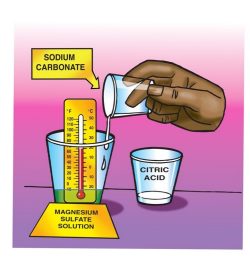
Procedure
- Add 5 drops of universal indicator to the magnesium sulfate solution.
- Place a thermometer in the cup and record the temperature of the solution.
- Add 10 mL of sodium carbonate solution.
- Add 10 mL of citric acid.
Expected Results
The magnesium sulfate, universal indicator, and sodium carbonate will turn purple and form a precipitate. With the addition of citric acid, the mixture will turn yellow or pink and bubble as the precipitate disappears. There is no noticeable temperature change.
Ask Students:
- What clues do you observe that let you know that a chemical reaction is taking place?
There is a color change, formation of a precipitate, another color change, and bubbling. - How can it be that in this chemical reaction, you did not notice a temperature change?
Maybe the amount of energy required to break bonds was about the same as the amount of energy released when bonds are formed. Or the temperature change was so small that it was not noticeable with student thermometers.
What is the 5-E format?
The 5-E instructional model is an approach to teaching and learning that focuses on active engagement, inquiry-based learning, and collaboration.
Simulations
Downloads
For Students
- Lesson 6.7 Student Activity Sheet PDF | DOCX | Google Doc
For Teachers
- Lesson 6.7 Lesson Plan PDF | DOCX | Google Doc
- Lesson 6.7 Activity Sheet Answers PDF | DOCX | Google Doc
- Lesson 6.7 Teacher Background PDF
Resources for the entire Chapter 6
- Chapter 6 Student Reading PDF | DOCX | Google Doc
- Chapter 6 Test Bank PDF | DOCX | Google Doc
Interactive Lesson Modules
- Lesson 6.7 Online Assignments Google Form
Have Questions? Visit Help Center

